Whenever I’ve taken a trip to Poland to see relatives, each household I’d visit–even if I only would be dropping by for a couple of hours–would always offer and serve tea or coffee with a homemade dessert. Yes, that’s right, a homemade dessert. ALWAYS. HOMEMADE. It’s almost like it would be committing the highest sin to buy dessert (or any prepared food, except bread), let alone serve it to guests. When there was time to whip up such homemade goodies–because it was never a one-bowl cake or easy cookies–is still a mystery to me. And the hostess would never serve the dessert with big fanfare. Tea and cake – what’s the big deal? It’s the least a hostess can offer guests who’ve been so kind as to drop by for a visit. And that’s that.
Many households you visit, especially if it’s spring, summer, or fall, will offer you a Polish fruit tart. It usually will be in “slab” form, meaning the tart is in the shape of a large rectangle. By large, I mean like 23 cm x 38 cm or 9 ” x 15 1/4″ or a lasagna pan, which is larger than the standard American 9″ x 13″ pan. There may be just a bottom crust, or it may have a bottom and full top crust, or a bottom crust with a crumb topping or latticed top crust, etc. The fruit can range from red currants (regular grocery stores carry them!) to a variety of berries to plums to peaches to the most common filling of all – apples. What might be shocking to the American palette is the low level of sweetness and lack of salt. When you bite into a piece, you first taste a semi-sweet short crust pastry and then a layer of baked fruit, which is either lightly sweetened or, more often than not, entirely unsweetened. The American pie is the reverse (pie crust has no sugar, but the filling tends to be very sweet). So while it might take some getting used to if you are a fan of American pies or even French tarts, the pluses of the Polish tart are that you won’t feel as if you are getting hit over the head with sugar, and you will taste the purity of the fruit.
The recipe below is for a peach tart, given that peaches are in season now and have been deliciously sweet and juicy so far this year. Any stone fruit or berry could be used instead. The quantity for berries is different than for stone fruit- around 3 cups of berries for a 9″ x 13″ pan (versus 3 to 4 pounds of peaches or nectarines; less if plums). The crust in this recipe is super easy because it does not require rolling out (but you could do it that way). There is a suggested top crust – a crumble top crust. I provide an alternative method for the top crust, which is to form a dough ball, freeze the dough, and then grate the frozen dough on top of the peaches before baking. A fruit tart like this one is a Polish staple–I hope you give it a try!
Below if the recipe and following the recipe are step-by-step instructions with photos. Please join me again after the recipe.
| Servings |
|
- 3 1/2 cups all-purpose flour
- 3/4 cup + 2 tablespoons granulated sugar
- 1 3/4 teaspoons baking powder
- 1 cup unsalted butter, cold and cut into tablespoon-size pieces [2 American sticks or 8 ounces or 226 g]
- 1 tablespoon white vinegar
- 2 tablespoons sour cream
- 5 large egg yolks
- 2 teaspoons vanilla extract
- 3 tablespoons bread crumbs
- 3 to 4 pounds/1.3 - 1.8 kg fresh peaches (or nectarines) [about 7-9 medium-large peaches]
- 1 tablespoon granulated sugar
- 1 teaspoon ground cinnamon (optional)
- 1/2 teaspoon ground nutmeg (optional)
- powdered sugar for dusting
Ingredients
Sweet Pastry Dough
Filling and Assembly
|
|
- In a large bowl, whisk together flour, sugar and baking powder. Cut in butter with 2 dinner knives or pastry cutter until flour/butter mixture is generally pea size, about 5-7 minutes.
- Make a well in center and add egg yolks, sour cream, vinegar, and vanilla extract to bowl. Using same 2 dinner knives, cut in while tossing wet ingredients with dry ingredients until evenly moistened and pea size, about 5 minutes.
- Press half of mixture into the bottom of an ungreased 13 x 9 x 2.25 inch (33 x 22.6 x 5.7 cm) baking pan. Set aside remaining flour-butter mixture, which will be later used to top the tart with a crumble crust.
- Alternative to crumble top crust: Gather the set aside flour-butter mixture into a ball of dough. Lightly and briefly knead so that dough comes together to form smooth dough ball. Wrap tightly in plastic wrap and place in one gallon Ziploc freezer bag. Freeze for at least one hour. While waiting, refrigerate pan with bottom crust. When top crust is fully frozen, proceed with making the filling.
- Preheat oven to 365°F/185°C, setting rack in the center of oven. Wash, peel and remove stones from peaches.* Slice in half. Slice each half into about 8 slices per half. Sprinkle bread crumbs evenly over bottom crust. Arrange peach slices on top, covering crust. Sprinkle 1 tablespoon granulated sugar and spices (if using) evenly over peach slices.
- Evenly sprinkle reserved dough crumble to cover peaches. [Alternative - If using frozen dough versus crumble, follow these instructions for top crust: Remove frozen dough from freezer, and unwrap all of part of dough from plastic wrap. Using the large holes of a hand-held grater, grate frozen dough over top peaches until evenly covered.]
- Bake in preheated oven for about 50 minutes to one hour, or until golden brown across the top. Dust with powdered sugar. Serve when fully cool to room temperature. [For best results, refrigerate an hour before serving.] Dust again with powdered sugar before serving if necessary. Store in refrigerator after 2 days.
* Plums may be substituted, but it is recommended to use less, about 2.2 to 3 pounds (1 kg/1.3 kg). Place plums skin-side down when arranging on the bottom crust. Sprinkle 2 tablespoons sugar (or more, to taste) instead of 1.
STEP-BY-STEP INSTRUCTIONS
An electric mixer is not necessary for this recipe. The pan to use is an American standard 9″ x 13″ x 2″ pan.
First, in a large bowl, whisk together the dry ingredients: 3 1/2 cups flour, 3/4 cups + 2T sugar, and 1 3/4 teaspoons baking powder.
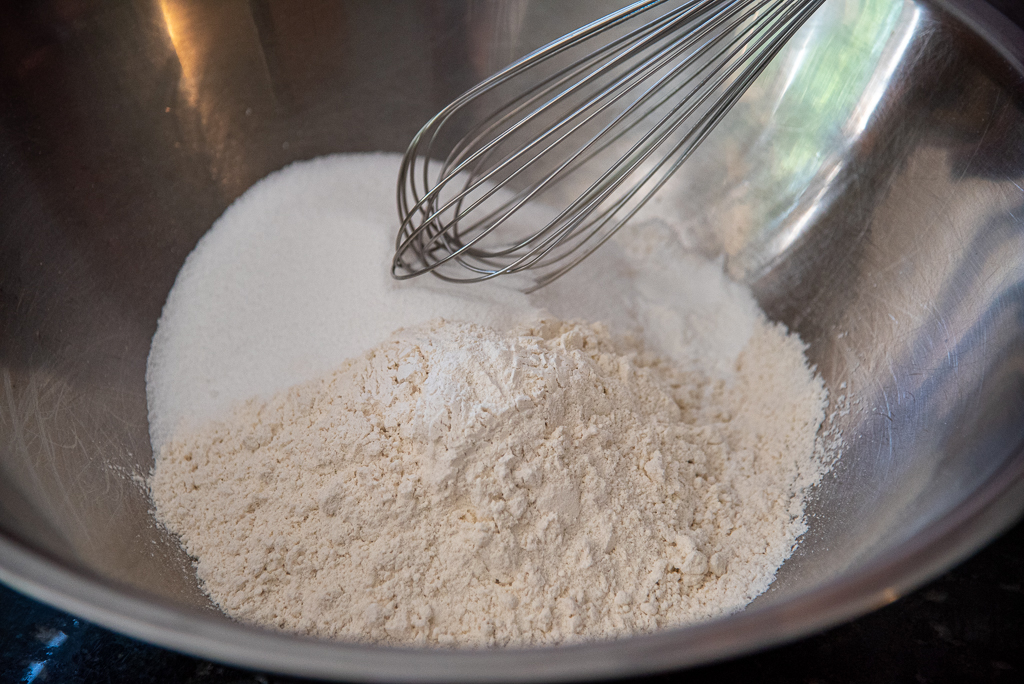
Cut up 2 American sticks (8 ounces/226 g) butter into tablespoon portions. Drop the pieces of butter into the center of the bowl on top of the flour.

With two dinner knives or a pastry cutter, cut the butter into the flour. It is slow going at first and you may want to give up after one minute, but keep at it for about 5-7 minutes. As you cut the butter in, bring the flour mixture from the outer area into the middle where you are working the butter.

Eventually, you will see pea-size hints of flour covered butter here and there. It’s time for the next step.

Make a well in the center and add 1 Tbsp + 2 tsp white vinegar, 2 Tbsp sour cream, 5 large egg yolks, and 2 teaspoons vanilla extract.

Take the same two knives you used before and cut the wet ingredients into the flour-butter mixture.
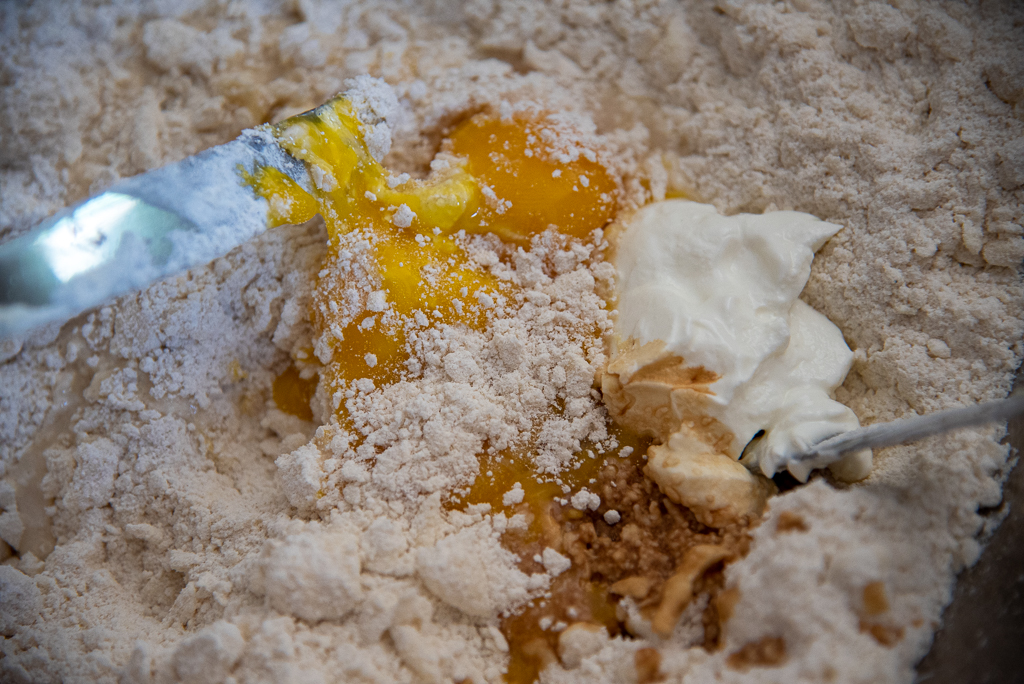
This will take close to 5 minutes.
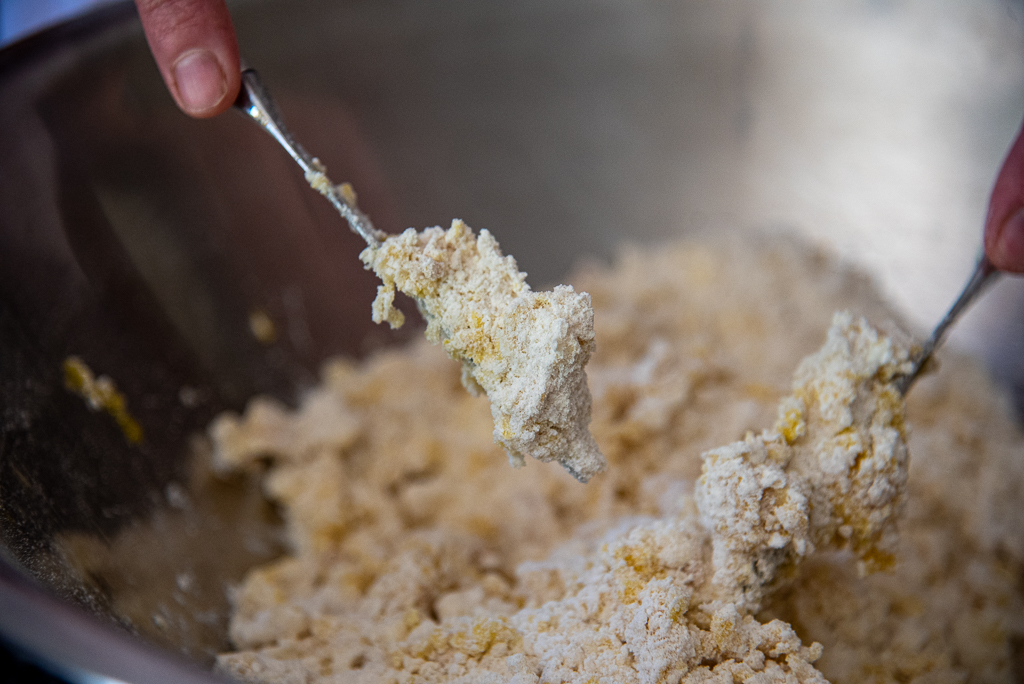
When it’s ready, you’ll see the bowl full of pea-size pieces of the egg-flour-butter mixture. At this point, there should not be any dry flour that hasn’t been mixed in.
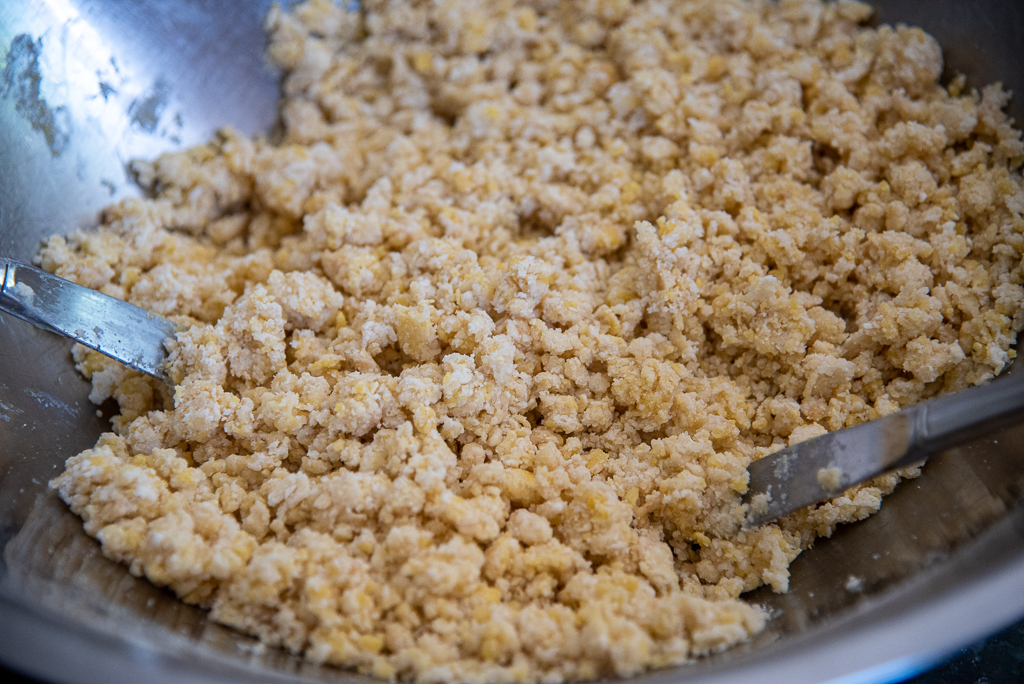
Press approximately half of the mixture into the bottom of the pan. The pan does not need to be greased, though I am sure it wouldn’t hurt.


Before you know it, the crumbs will turn into a solid crust.
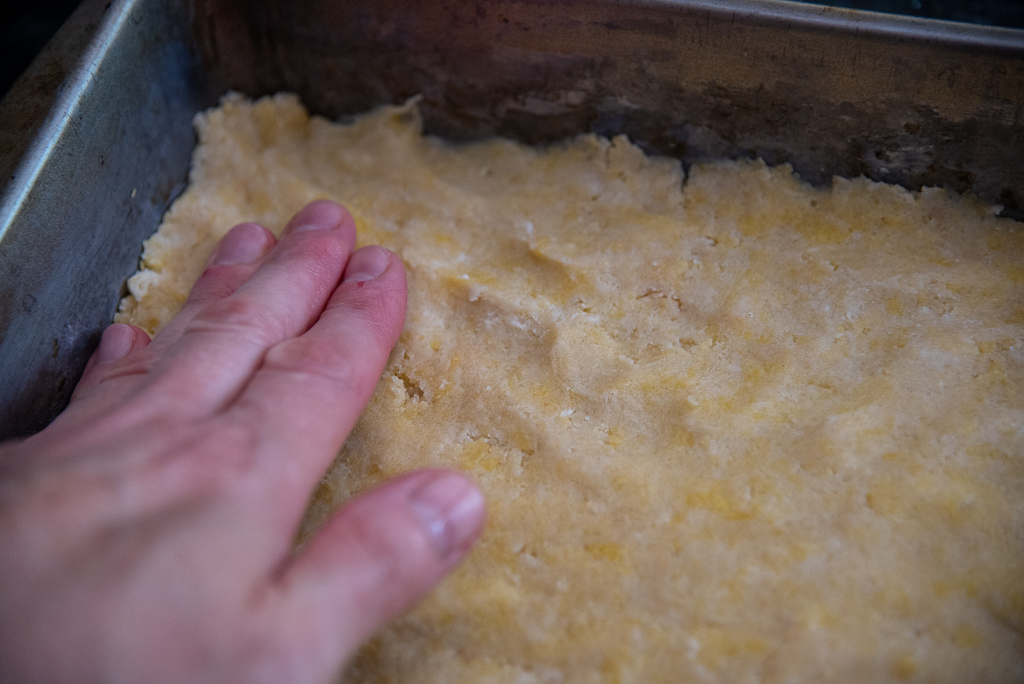

Set aside the remaining portion of the pastry dough for the crumbled top crust. An alternative top crust is one where the dough is grated on top. To prepare this type of top crust, cup your hands and bring the crumbs together in the center of the bowl to form a ball, lightly kneading so that the dough sticks together. Then wrap the ball in plastic wrap, place it in a 1 gallon Ziploc freezer bag, and freeze for about an hour. See the instructions later on below for when and how to grate the frozen pastry dough for the top crust.

It’s time to prepare the peaches. While you are doing this, you can keep the bottom crust in the refrigerator, but it’s not required so long as you don’t dilly dally with the peaches. Preheat the oven to 365°F/185°C.
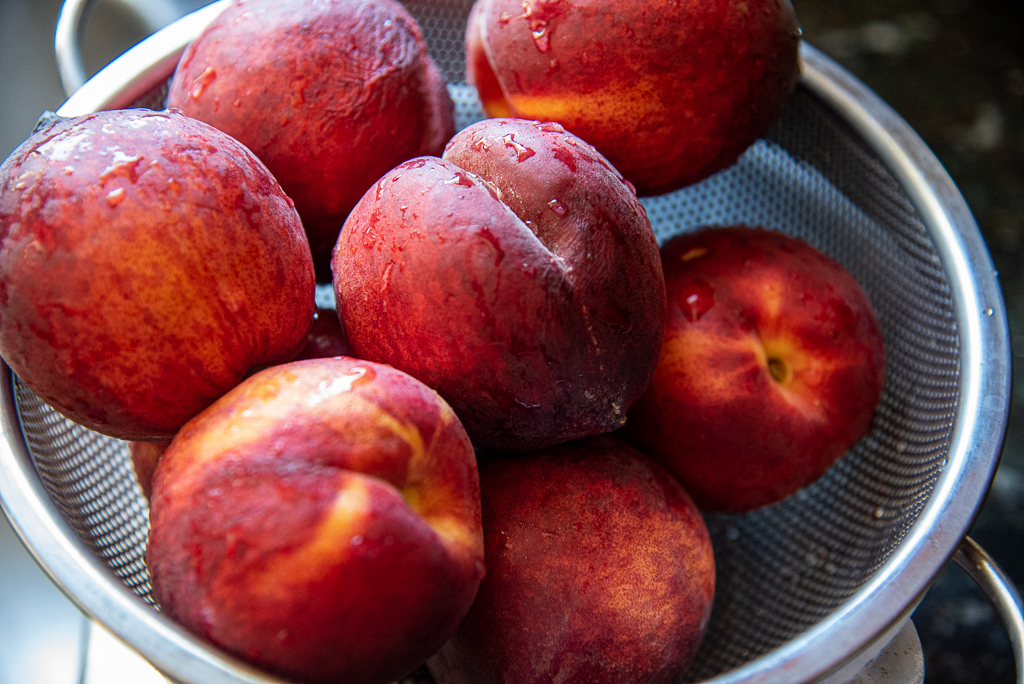
Peel, stone, and slice the peaches. I tend to slice each half peach into about 8 slices.

Now go back to the crust lined pan. Sprinkle 3 tablespoons of bread crumbs over top. This will absorb some of the juices from the peaches as they bake.
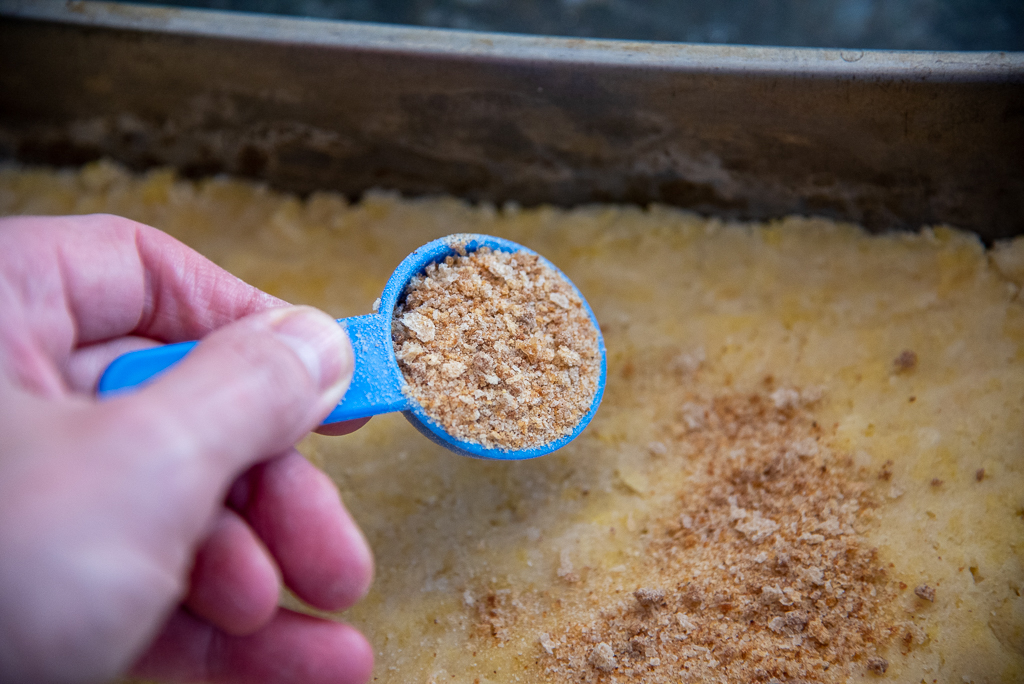
Then arrange the peach slices over top the crust.

Sprinkle 1 tablespoon of sugar over the peaches. If you’d like some extra flavor and spice, sprinkle 1 teaspoon cinnamon and 1/2 teaspoon nutmeg.

By this time, the oven is probably fully preheated and ready to go. You need to top the peaches with a top crust. If you chose to freeze a ball of dough for the top crust, unwrap most of the dough, hold the dough from the wrapped end, and grate exposed dough (large holes) in an even layer over top of the peaches.
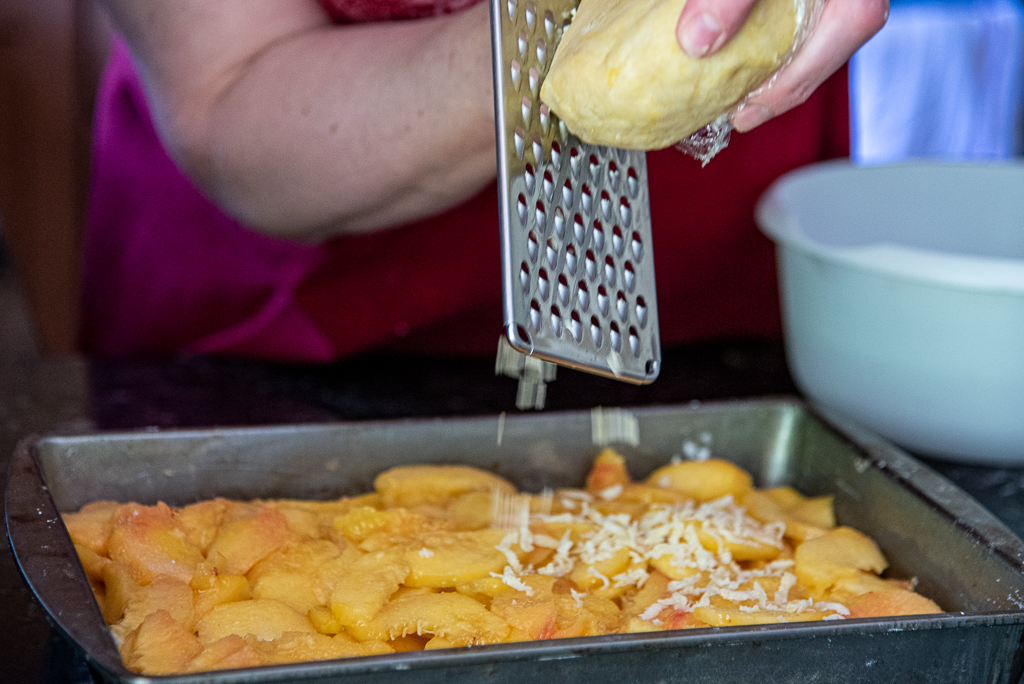
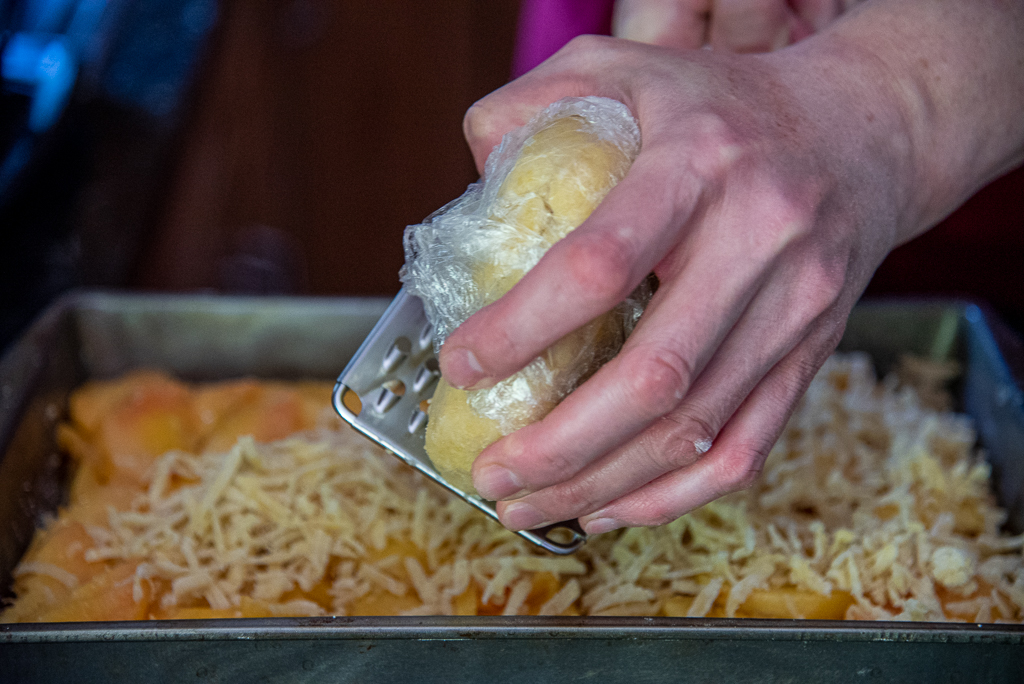
Here is what it looks like with grated dough as the top crust.

If you are choosing the “crumb top crust” method, you have got an easy task ahead. Just distribute the reserved pastry crumbs in an even layer over top the peaches.


Bake in the preheated oven for 50 minutes to 1 hour, or until it’s golden brown across the top. You may see a lot of juice around the edges. You needn’t worry about that because when the tart cools, you’ll wonder where it all went. Last time I made this tart, I used a little over 4 pounds of juicy fruit, which seemed like a crazy amount of peaches. I was worried that the baking juices would be too much for the crust to handle. I thought for sure that the bottom crust would end up soggy. I worried for nothing – the crust was just fine and the abundance of baked peaches was delicious.
After you remove the tart from the oven, dust with powdered sugar. Some of it will melt into the warm top crust, and some of it will stay.
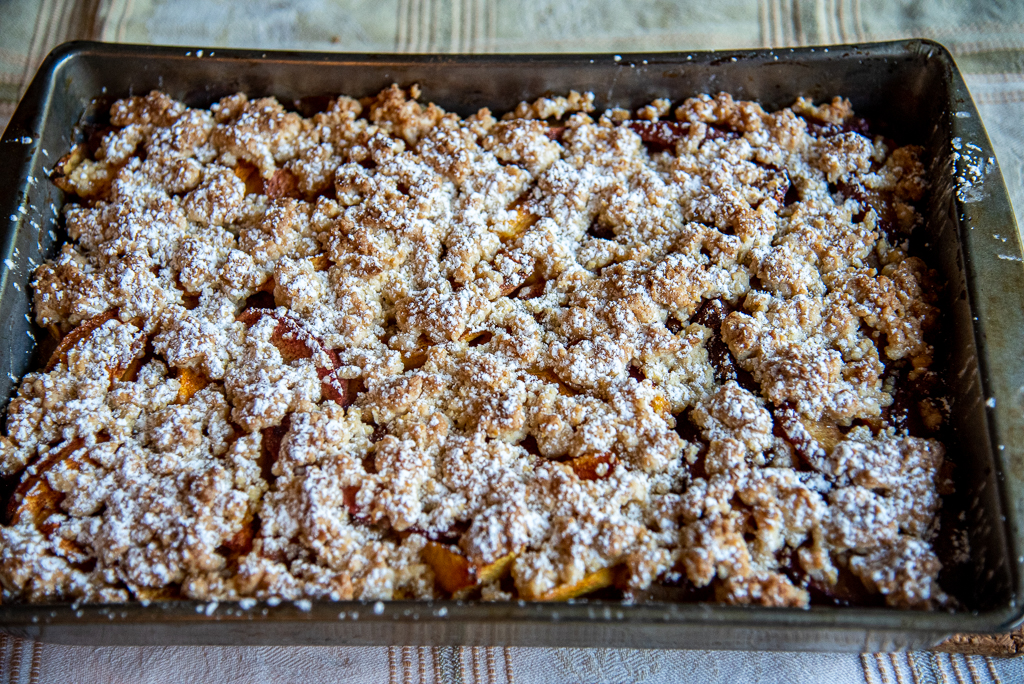
When completely cool, refresh with more powdered sugar if necessary and cut into squares to serve. Here is a top view of a slice where the top crust was made with grated dough.
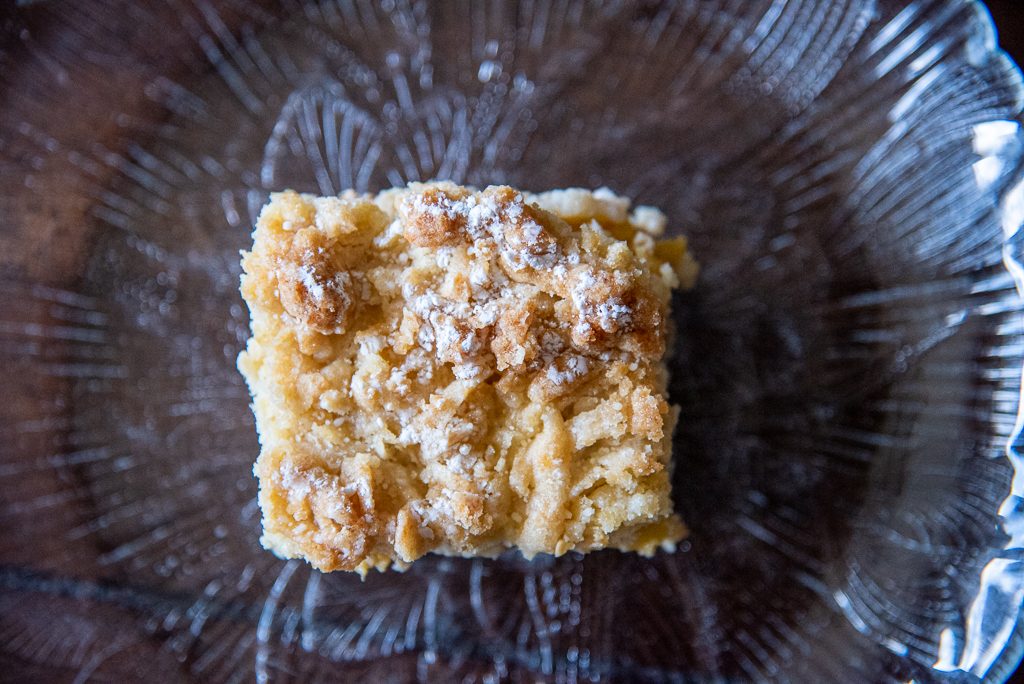
The photo below is from a side angle of a tart I made with about 3 1/2 pounds of peaches. It may appear to be a thin layer of peaches, but it didn’t taste that way!

This Polish classic is a refreshing tart and a must try for summer. Smacznego!




